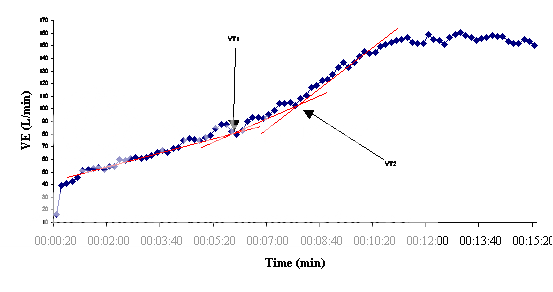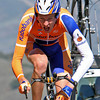|
Watts
|
| ruben |
Posted on 20-01-2009 21:58
|

Team Leader

Posts: 7125
Joined: 23-10-2006
PCM$: 200.00
|
Aquarius favourite subject no doubt 
Anyway, Robert Gesink threw online his trainings results at the beginning of each year since he became a pro. They do 6 blocks of 6 minutes at a certain hart rate (in dutch: omslagpunt, in english: some sort of threshold, dunno how to translate).
Each year, you can see how much power you put out at the same heart rate. Here, in Gesink's result, he is clearly improving, the improvement between 2007 and 2008 is even frightening, but in 2009 the improvement is not as huge, which is logical, because if he made a jump of 40W there he would be a uberhuman.
The important blocks are 2 to 7, the green figures are most important 

2008

An improvement of 40W on all aspects...wow.

An improvement of about 10/15W, he is nearing his maximum potential already me thinks. Unless he can keep improving at 10/15W a year   Still wow. For such a young rider. Still wow. For such a young rider.
Anyway, I wish more riders did this. You can really see the progression this guy made. It would be nice to see this for other riders. I would like to know for instance if Popovych improved at all since his espoir period  |
| |
|
|
| weekendwarrior |
Posted on 20-01-2009 22:15
|
Amateur

Posts: 12
Joined: 14-07-2008
PCM$: 200.00
|
Wow those are some very impressive stats and also really exciting. I know during the tour on the SRM website they put the power, HR etc stats up which is cool to see but this is really interesting. I too wish more pro's did this so amateurs like myself could learn what sort of intensity/duration/HR etc they train off. Really interesting. I think Gesink will keep improving but at a steady rate. |
| |
|
|
| weekendwarrior |
Posted on 20-01-2009 22:17
|
Amateur

Posts: 12
Joined: 14-07-2008
PCM$: 200.00
|
But it doesnt say what altitude he is training at so this could be flat terrain and by the power output i would suggest it is. It might suggest his TT potential is limited? |
| |
|
|
| issoisso |
Posted on 20-01-2009 22:19
|
Tour de France Champion

Posts: 19134
Joined: 08-02-2007
PCM$: 200.00
|
Ruben wrote:
the improvement between 2007 and 2008 is even frightening
First vs. Second pro season. Very normal improvement, I'm afraid. As surprising as that is.
His power/weight ratio for his age, though, is insane.
Edited by issoisso on 20-01-2009 22:26
|
| |
|
|
| ruben |
Posted on 20-01-2009 22:54
|

Team Leader

Posts: 7125
Joined: 23-10-2006
PCM$: 200.00
|
Believe me Isso, I have contact with a lot of young Dutch riders as you know, and none of them made an improvement of 40 fucking watts between first and second season.
It's insane. |
| |
|
|
| rjc_43 |
Posted on 20-01-2009 23:00
|

Team Leader

Posts: 6490
Joined: 13-10-2007
PCM$: 200.00
|
It is dependent on how fit the rider is at the specific time as well... it may have been that he was at a higher wattage last year, just wasn't peaking early, or he's peaking earlier this year. But yes, if his fitness is the same, then it is extraordinarily good improvement.
[url=cleavercycling.co.uk]  [/url] |
| |
|
|
| ruben |
Posted on 20-01-2009 23:07
|

Team Leader

Posts: 7125
Joined: 23-10-2006
PCM$: 200.00
|
This is all the same, all start of the season build up.
Maybe the only slight difference is that this year he started training 2 weeks later because he wants to peak first in the April classics rather than Paris Nice like last year. |
| |
|
|
| rjc_43 |
Posted on 20-01-2009 23:09
|

Team Leader

Posts: 6490
Joined: 13-10-2007
PCM$: 200.00
|
In which case, there are three arguments: he's on something, the extra rest has done him the world of good, or he's just had something in his body click into place due to a high intensity season of pro racing.
[url=cleavercycling.co.uk]  [/url] |
| |
|
|
| ruben |
Posted on 20-01-2009 23:16
|

Team Leader

Posts: 7125
Joined: 23-10-2006
PCM$: 200.00
|
Gesink is simply a bigger talent than the guys I know their results of (langeveld, maaskant, duyn, de maar, etc) |
| |
|
|
| rjc_43 |
Posted on 20-01-2009 23:21
|

Team Leader

Posts: 6490
Joined: 13-10-2007
PCM$: 200.00
|
It would also be fairly interesting to see his VO2 values, and of course the CO2 values, to see where his lactate threshold is, and other points. That way performance can be predicted fairly accurately.
[url=cleavercycling.co.uk]  [/url] |
| |
|
|
| Ad Bot |
Posted on 17-12-2025 00:58
|
Bot Agent
Posts: Countless
Joined: 23.11.09
|
|
| IP: None |
|
|
| ruben |
Posted on 20-01-2009 23:24
|

Team Leader

Posts: 7125
Joined: 23-10-2006
PCM$: 200.00
|
It's known Gesink has a vo2max above 80, it was 82,5 or something.
I'll look it up.
EDIT: pretty sure I have it in one of the wielerrevue issues... but that's a long search lol (it's a magazine)
Edited by ruben on 20-01-2009 23:26
|
| |
|
|
| rjc_43 |
Posted on 20-01-2009 23:29
|

Team Leader

Posts: 6490
Joined: 13-10-2007
PCM$: 200.00
|
Thats usual of riders. However, that rate is unsustainable for long periods. I'm more interested in finding the specific wattage which he can sustain for a long period of time - such as in climbing. However, you need both the oxygen uptake in ml.kg.min-1 and carbon dioxide outtake (so to speak) also in ml.kg.min-1. That way you can draw three lines on it. Finding the different thresholds which all you to predict performance down to the fine line.
[url=cleavercycling.co.uk]  [/url] |
| |
|
|
| ruben |
Posted on 20-01-2009 23:31
|

Team Leader

Posts: 7125
Joined: 23-10-2006
PCM$: 200.00
|
Well all I know of Delahaye's interviews, Gesink is the man of exceptional test results, on all aspects. I have to find this article to explain better.
Although you have to conclude test results don't say all in a race. You can have exceptional physical qualities, if you are not mentally stable, have fear of riding in the peloton, or can't take a corner, you'll still have no use for them 
I do know that nobody in the history of the Rabobank team (since 1996) had results near those of Gesink.
Edited by ruben on 20-01-2009 23:31
|
| |
|
|
| rjc_43 |
Posted on 20-01-2009 23:35
|

Team Leader

Posts: 6490
Joined: 13-10-2007
PCM$: 200.00
|
For a quick, and simple, example:

This is recorded data from myself from a simple VO2 test, going up in increments of 30 watts every time slot (can't remember the gaps).
From the lines drawn, you can see the points of interest, Ventilatory threshold 1 and 2. With both O2 and CO2 data on a chart, its much easier to see (if you have any common sense, which most do). VT1 is the point that more carbon dioxide starts being produced than O2 being inhaled and utlilised. Basically it signifies the production of lactic acid. Past VT2, and lactic acid builds up rapidly. Between VT1 and VT2, you can sustain that pace for a long period of time, defined by the amount of glucose available and how fatigued your muscles get. Below VT1 the pace is sustainable potentially for ever if you have an unlimited supply of fat. Above VT2 you cannot continue for long. Depends on the ability of you body to cope with lactic acid and work under high intensities.
[url=cleavercycling.co.uk]  [/url] |
| |
|
|
| Deadpool |
Posted on 20-01-2009 23:47
|
Team Leader

Posts: 6727
Joined: 06-10-2007
PCM$: 200.00
|
I must note that your avatar's make this conversation hilarious. They look like they are looking at each other.....
I don't know why, it just struck me as very funny |
| |
|
|
| habbe |
Posted on 08-08-2012 21:06
|

Amateur

Posts: 1
Joined: 12-03-2012
PCM$: 200.00
|
.
Edited by habbe on 08-08-2012 21:58
|
| |
|
|
| Aquarius |
Posted on 08-08-2012 21:23
|
Grand Tour Specialist

Posts: 4851
Joined: 29-11-2006
PCM$: 200.00
|
I know I had read this topic years ago, but I had no memory from rjc's message.
Interesting reading, if you like physiology. 
VT1 is what we (abusively) called anaerobic threshold, whereas VT2 is what we (still) call max aerobic power. Even my swimmer friend's coach uses that.
VT1 was wrongfully called anaerobic threshold because anaerobic reactions already happen (but in minor quantities) below that threshold.
The difference is that the effort tests I passed were "indirect" so to speak, as there was no measurement of the air we breathed. VT1 was where the Watts per heart beat curve started bending, whereas VT2 would be where the curve ended.
Difference was reputed to be around 3% (above or under) between both methods.
Those two thresholds match heart beat values, for those who ask. I can remember Virenque in 1994 dropping an opponent in the Pyrénées by constantly checking his (opponents' ) heart monitor while accelerating. Once he had figured what his threshold was, he just dropped it by increasing the pace to nothing more than what it would take to drop him. That worked perfectly. I'm no Virenque fan, but that was a perfect example to show how you can smartly exploit data.
Edited by Aquarius on 08-08-2012 21:24
|
| |
|










 Still wow. For such a young rider.
Still wow. For such a young rider. 







